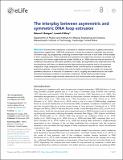| dc.contributor.author | Banigan, Edward J | |
| dc.contributor.author | Mirny, Leonid A | |
| dc.date.accessioned | 2021-12-09T13:20:17Z | |
| dc.date.available | 2021-12-09T13:20:17Z | |
| dc.date.issued | 2020 | |
| dc.identifier.uri | https://hdl.handle.net/1721.1/138403 | |
| dc.description.abstract | © Banigan and Mirny. Chromosome compaction is essential for reliable transmission of genetic information. Experiments suggest that -1000-fold compaction is driven by condensin complexes that extrude chromatin loops, by progressively collecting chromatin fiber from one or both sides of the complex to form a growing loop. Theory indicates that symmetric two-sided loop extrusion can achieve such compaction, but recent single-molecule studies (Golfier et al., 2020) observed diverse dynamics of condensins that perform one-sided, symmetric two-sided, and asymmetric two-sided extrusion. We use simulations and theory to determine how these molecular properties lead to chromosome compaction. High compaction can be achieved if even a small fraction of condensins have two essential properties: A long residence time and the ability to perform two-sided (not necessarily symmetric) extrusion. In mixtures of condensins I and II, coupling two-sided extrusion and stable chromatin binding by condensin II promotes compaction. These results provide missing connections between single-molecule observations and chromosome-scale organization. | en_US |
| dc.language.iso | en | |
| dc.publisher | eLife Sciences Publications, Ltd | en_US |
| dc.relation.isversionof | 10.7554/ELIFE.63528 | en_US |
| dc.rights | Creative Commons Attribution 4.0 International license | en_US |
| dc.rights.uri | https://creativecommons.org/licenses/by/4.0/ | en_US |
| dc.source | eLife | en_US |
| dc.title | The interplay between asymmetric and symmetric DNA loop extrusion | en_US |
| dc.type | Article | en_US |
| dc.identifier.citation | Banigan, Edward J and Mirny, Leonid A. 2020. "The interplay between asymmetric and symmetric DNA loop extrusion." eLife, 9. | |
| dc.contributor.department | Massachusetts Institute of Technology. Department of Physics | |
| dc.contributor.department | Massachusetts Institute of Technology. Institute for Medical Engineering & Science | |
| dc.relation.journal | eLife | en_US |
| dc.eprint.version | Final published version | en_US |
| dc.type.uri | http://purl.org/eprint/type/JournalArticle | en_US |
| eprint.status | http://purl.org/eprint/status/PeerReviewed | en_US |
| dc.date.updated | 2021-12-09T13:17:53Z | |
| dspace.orderedauthors | Banigan, EJ; Mirny, LA | en_US |
| dspace.date.submission | 2021-12-09T13:17:55Z | |
| mit.journal.volume | 9 | en_US |
| mit.license | PUBLISHER_CC | |
| mit.metadata.status | Authority Work and Publication Information Needed | en_US |
